Spring Batch Integration
Many users of Spring Batch may encounter requirements that are outside the scope of Spring Batch but that may be efficiently and concisely implemented by using Spring Integration. Conversely, Spring Integration users may encounter Spring Batch requirements and need a way to efficiently integrate both frameworks. In this context, several patterns and use-cases emerge, and Spring Batch Integration addresses those requirements.
The line between Spring Batch and Spring Integration is not always clear, but two pieces of advice can help: Thinking about granularity and applying common patterns. Some of those common patterns are described in this section.
Adding messaging to a batch process enables automation of operations and also separation and strategizing of key concerns. For example, a message might trigger a job to execute, and then sending the message can be exposed in a variety of ways. Alternatively, when a job completes or fails, that event might trigger a message to be sent, and the consumers of those messages might have operational concerns that have nothing to do with the application itself. Messaging can also be embedded in a job (for example, reading or writing items for processing through channels). Remote partitioning and remote chunking provide methods to distribute workloads over a number of workers.
This section covers the following key concepts:
Namespace Support
Dedicated XML namespace support was added to Spring Batch Integration in version 1.3, with the aim to provide an easier configuration experience. To use the namespace, add the following namespace declarations to your Spring XML Application Context file:
<beans xmlns="http://www.springframework.org/schema/beans"
xmlns:xsi="http://www.w3.org/2001/XMLSchema-instance"
xmlns:batch-int="http://www.springframework.org/schema/batch-integration"
xsi:schemaLocation="
http://www.springframework.org/schema/batch-integration
https://www.springframework.org/schema/batch-integration/spring-batch-integration.xsd">
...
</beans>The following example shows a fully configured Spring XML application context file for Spring Batch Integration:
<beans xmlns="http://www.springframework.org/schema/beans"
xmlns:xsi="http://www.w3.org/2001/XMLSchema-instance"
xmlns:int="http://www.springframework.org/schema/integration"
xmlns:batch="http://www.springframework.org/schema/batch"
xmlns:batch-int="http://www.springframework.org/schema/batch-integration"
xsi:schemaLocation="
http://www.springframework.org/schema/batch-integration
https://www.springframework.org/schema/batch-integration/spring-batch-integration.xsd
http://www.springframework.org/schema/batch
https://www.springframework.org/schema/batch/spring-batch.xsd
http://www.springframework.org/schema/beans
https://www.springframework.org/schema/beans/spring-beans.xsd
http://www.springframework.org/schema/integration
https://www.springframework.org/schema/integration/spring-integration.xsd">
...
</beans>Appending version numbers to the referenced XSD file is also allowed. However, because a version-less declaration always uses the latest schema, we generally do not recommend appending the version number to the XSD name. Adding a version number could possibly create issues when updating the Spring Batch Integration dependencies, as they may require more recent versions of the XML schema.
Launching Batch Jobs through Messages
When starting batch jobs by using the core Spring Batch API, you basically have two options:
-
From the command line, with the
CommandLineJobRunner -
Programmatically, with either
JobOperator.start()orJobLauncher.run()
For example, you may want to use the
CommandLineJobRunner when invoking batch jobs by
using a shell script. Alternatively, you can use the
JobOperator directly (for example, when using
Spring Batch as part of a web application). However, what about
more complex use cases? Maybe you need to poll a remote (S)FTP
server to retrieve the data for the Batch Job or your application
has to support multiple different data sources simultaneously. For
example, you may receive data files not only from the web but also from
FTP and other sources. Maybe additional transformation of the input files is
needed before invoking Spring Batch.
Therefore, it would be much more powerful to execute the batch job
by using Spring Integration and its numerous adapters. For example,
you can use a File Inbound Channel Adapter to
monitor a directory in the file-system and start the batch job as
soon as the input file arrives. Additionally, you can create Spring
Integration flows that use multiple different adapters to easily
ingest data for your batch jobs from multiple sources
simultaneously by using only configuration. Implementing all these
scenarios with Spring Integration is easy, as it allows for
decoupled, event-driven execution of the
JobLauncher.
Spring Batch Integration provides the
JobLaunchingMessageHandler class that you can
use to launch batch jobs. The input for the
JobLaunchingMessageHandler is provided by a
Spring Integration message, which has a payload of type
JobLaunchRequest. This class is a wrapper around the Job
to be launched and around the JobParameters that are
necessary to launch the Batch job.
The following image shows the typical Spring Integration message flow that is needed to start a Batch job. The EIP (Enterprise Integration Patterns) website provides a full overview of messaging icons and their descriptions.
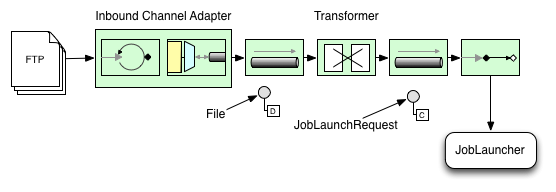
Transforming a File into a JobLaunchRequest
The following example transforms a file into a JobLaunchRequest:
package io.spring.sbi;
public class FileMessageToJobRequest {
private Job job;
private String fileParameterName;
public void setFileParameterName(String fileParameterName) {
this.fileParameterName = fileParameterName;
}
public void setJob(Job job) {
this.job = job;
}
@Transformer
public JobLaunchRequest toRequest(Message<File> message) {
JobParametersBuilder jobParametersBuilder =
new JobParametersBuilder();
jobParametersBuilder.addString(fileParameterName,
message.getPayload().getAbsolutePath());
return new JobLaunchRequest(job, jobParametersBuilder.toJobParameters());
}
}
The JobExecution Response
When a batch job is being executed, a
JobExecution instance is returned. You can use this
instance to determine the status of an execution. If
a JobExecution is able to be created
successfully, it is always returned, regardless of whether
or not the actual execution is successful.
The exact behavior on how the JobExecution
instance is returned depends on the provided
TaskExecutor. If a
synchronous (single-threaded)
TaskExecutor implementation is used, the
JobExecution response is returned only
after the job completes. When using an
asynchronous
TaskExecutor, the
JobExecution instance is returned
immediately. You can then take the id of
JobExecution instance
(with JobExecution.getJobId()) and query the
JobRepository for the job’s updated status
using the JobExplorer. For more
information, see
Querying the Repository.
Spring Batch Integration Configuration
Consider a case where someone needs to create a file inbound-channel-adapter to listen
for CSV files in the provided directory, hand them off to a transformer
(FileMessageToJobRequest), launch the job through the job launching gateway, and
log the output of the JobExecution with the logging-channel-adapter.
The following example shows how that common case can be configured in XML: .XML Configuration
<int:channel id="inboundFileChannel"/>
<int:channel id="outboundJobRequestChannel"/>
<int:channel id="jobLaunchReplyChannel"/>
<int-file:inbound-channel-adapter id="filePoller"
channel="inboundFileChannel"
directory="file:/tmp/myfiles/"
filename-pattern="*.csv">
<int:poller fixed-rate="1000"/>
</int-file:inbound-channel-adapter>
<int:transformer input-channel="inboundFileChannel"
output-channel="outboundJobRequestChannel">
<bean class="io.spring.sbi.FileMessageToJobRequest">
<property name="job" ref="personJob"/>
<property name="fileParameterName" value="input.file.name"/>
</bean>
</int:transformer>
<batch-int:job-launching-gateway request-channel="outboundJobRequestChannel"
reply-channel="jobLaunchReplyChannel"/>
<int:logging-channel-adapter channel="jobLaunchReplyChannel"/>The following example shows how that common case can be configured in Java:
@Bean
public FileMessageToJobRequest fileMessageToJobRequest() {
FileMessageToJobRequest fileMessageToJobRequest = new FileMessageToJobRequest();
fileMessageToJobRequest.setFileParameterName("input.file.name");
fileMessageToJobRequest.setJob(personJob());
return fileMessageToJobRequest;
}
@Bean
public JobLaunchingGateway jobLaunchingGateway() {
TaskExecutorJobLauncher jobLauncher = new TaskExecutorJobLauncher();
jobLauncher.setJobRepository(jobRepository);
jobLauncher.setTaskExecutor(new SyncTaskExecutor());
JobLaunchingGateway jobLaunchingGateway = new JobLaunchingGateway(jobLauncher);
return jobLaunchingGateway;
}
@Bean
public IntegrationFlow integrationFlow(JobLaunchingGateway jobLaunchingGateway) {
return IntegrationFlow.from(Files.inboundAdapter(new File("/tmp/myfiles")).
filter(new SimplePatternFileListFilter("*.csv")),
c -> c.poller(Pollers.fixedRate(1000).maxMessagesPerPoll(1))).
transform(fileMessageToJobRequest()).
handle(jobLaunchingGateway).
log(LoggingHandler.Level.WARN, "headers.id + ': ' + payload").
get();
}
Example ItemReader Configuration
Now that we are polling for files and launching jobs, we need to configure our Spring
Batch ItemReader (for example) to use the files found at the location defined by the job
parameter called "input.file.name", as the following bean configuration shows:
The following XML example shows the necessary bean configuration:
<bean id="itemReader" class="org.springframework.batch.item.file.FlatFileItemReader"
scope="step">
<property name="resource" value="file://#{jobParameters['input.file.name']}"/>
...
</bean>The following Java example shows the necessary bean configuration:
@Bean
@StepScope
public ItemReader sampleReader(@Value("#{jobParameters[input.file.name]}") String resource) {
...
FlatFileItemReader flatFileItemReader = new FlatFileItemReader();
flatFileItemReader.setResource(new FileSystemResource(resource));
...
return flatFileItemReader;
}
The main points of interest in the preceding example are injecting the value of
#{jobParameters['input.file.name']}
as the Resource property value and setting the ItemReader bean
to have step scope. Setting the bean to have step scope takes advantage of
the late binding support, which allows access to the
jobParameters variable.
Available Attributes of the Job-Launching Gateway
The job-launching gateway has the following attributes that you can set to control a job:
-
id: Identifies the underlying Spring bean definition, which is an instance of either:-
EventDrivenConsumer -
PollingConsumer(The exact implementation depends on whether the component’s input channel is aSubscribableChannelor aPollableChannel.)
-
-
auto-startup: Boolean flag to indicate that the endpoint should start automatically on startup. The default istrue. -
request-channel: The inputMessageChannelof this endpoint. -
reply-channel:MessageChannelto which the resultingJobExecutionpayload is sent. -
reply-timeout: Lets you specify how long (in milliseconds) this gateway waits for the reply message to be sent successfully to the reply channel before throwing an exception. This attribute applies only when the channel might block (for example, when using a bounded queue channel that is currently full). Also, keep in mind that, when sending to aDirectChannel, the invocation occurs in the sender’s thread. Therefore, the failing of the send operation may be caused by other components further downstream. Thereply-timeoutattribute maps to thesendTimeoutproperty of the underlyingMessagingTemplateinstance. If not specified, the attribute defaults to -1, meaning that, by default, theGatewaywaits indefinitely. -
job-launcher: Optional. Accepts a customJobLauncherbean reference. If not specified, the adapter re-uses the instance that is registered under theidofjobLauncher. If no default instance exists, an exception is thrown. -
order: Specifies the order of invocation when this endpoint is connected as a subscriber to aSubscribableChannel.
Sub-elements
When this Gateway is receiving messages from a
PollableChannel, you must either provide
a global default Poller or provide a Poller sub-element to the
Job Launching Gateway.
The following example shows how to provide a poller in XML:
<batch-int:job-launching-gateway request-channel="queueChannel"
reply-channel="replyChannel" job-launcher="jobLauncher">
<int:poller fixed-rate="1000">
</batch-int:job-launching-gateway>The following example shows how to provide a poller in Java:
@Bean
@ServiceActivator(inputChannel = "queueChannel", poller = @Poller(fixedRate="1000"))
public JobLaunchingGateway sampleJobLaunchingGateway() {
JobLaunchingGateway jobLaunchingGateway = new JobLaunchingGateway(jobLauncher());
jobLaunchingGateway.setOutputChannel(replyChannel());
return jobLaunchingGateway;
}
Providing Feedback with Informational Messages
As Spring Batch jobs can run for long times, providing progress information is often critical. For example, stakeholders may want to be notified if some or all parts of a batch job have failed. Spring Batch provides support for this information being gathered through:
-
Active polling
-
Event-driven listeners
When starting a Spring Batch job asynchronously (for example, by using the Job Launching
Gateway), a JobExecution instance is returned. Thus, you can use JobExecution.getJobId()
to continuously poll for status updates by retrieving updated instances of the
JobExecution from the JobRepository by using the JobExplorer. However, this is
considered sub-optimal, and an event-driven approach is preferred.
Therefore, Spring Batch provides listeners, including the three most commonly used listeners:
-
StepListener -
ChunkListener -
JobExecutionListener
In the example shown in the following image, a Spring Batch job has been configured with a
StepExecutionListener. Thus, Spring Integration receives and processes any step before
or after events. For example, you can inspect the received StepExecution by using a
Router. Based on the results of that inspection, various things can occur (such as
routing a message to a mail outbound channel adapter), so that an email notification can
be sent out based on some condition.
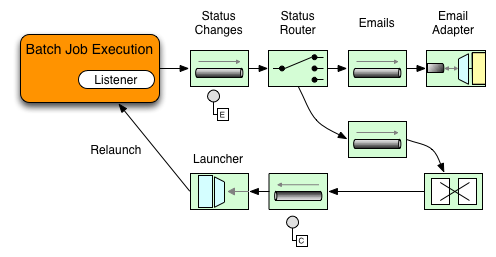
The following two-part example shows how a listener is configured to send a
message to a Gateway for a StepExecution events and log its output to a
logging-channel-adapter.
First, create the notification integration beans.
The following example shows the how to create the notification integration beans in XML:
<int:channel id="stepExecutionsChannel"/>
<int:gateway id="notificationExecutionsListener"
service-interface="org.springframework.batch.core.StepExecutionListener"
default-request-channel="stepExecutionsChannel"/>
<int:logging-channel-adapter channel="stepExecutionsChannel"/>The following example shows the how to create the notification integration beans in Java:
@Bean
@ServiceActivator(inputChannel = "stepExecutionsChannel")
public LoggingHandler loggingHandler() {
LoggingHandler adapter = new LoggingHandler(LoggingHandler.Level.WARN);
adapter.setLoggerName("TEST_LOGGER");
adapter.setLogExpressionString("headers.id + ': ' + payload");
return adapter;
}
@MessagingGateway(name = "notificationExecutionsListener", defaultRequestChannel = "stepExecutionsChannel")
public interface NotificationExecutionListener extends StepExecutionListener {}
You need to add the @IntegrationComponentScan annotation to your configuration.
|
Second, modify your job to add a step-level listener.
The following example shows the how to add a step-level listener in XML:
<job id="importPayments">
<step id="step1">
<tasklet ../>
<chunk ../>
<listeners>
<listener ref="notificationExecutionsListener"/>
</listeners>
</tasklet>
...
</step>
</job>The following example shows the how to add a step-level listener in Java:
public Job importPaymentsJob() {
return jobBuilderFactory.get("importPayments")
.start(stepBuilderFactory.get("step1")
.chunk(200)
.listener(notificationExecutionsListener())
...
)
}
Asynchronous Processors
Asynchronous Processors help you scale the processing of items. In the asynchronous
processor use case, an AsyncItemProcessor serves as a dispatcher, executing the logic of
the ItemProcessor for an item on a new thread. Once the item completes, the Future is
passed to the AsynchItemWriter to be written.
Therefore, you can increase performance by using asynchronous item processing, basically
letting you implement fork-join scenarios. The AsyncItemWriter gathers the results and
writes back the chunk as soon as all the results become available.
The following example shows how to configuration the AsyncItemProcessor in XML:
<bean id="processor"
class="org.springframework.batch.integration.async.AsyncItemProcessor">
<property name="delegate">
<bean class="your.ItemProcessor"/>
</property>
<property name="taskExecutor">
<bean class="org.springframework.core.task.SimpleAsyncTaskExecutor"/>
</property>
</bean>The following example shows how to configuration the AsyncItemProcessor in XML:
@Bean
public AsyncItemProcessor processor(ItemProcessor itemProcessor, TaskExecutor taskExecutor) {
AsyncItemProcessor asyncItemProcessor = new AsyncItemProcessor();
asyncItemProcessor.setTaskExecutor(taskExecutor);
asyncItemProcessor.setDelegate(itemProcessor);
return asyncItemProcessor;
}
The delegate property refers to your ItemProcessor bean, and the taskExecutor
property refers to the TaskExecutor of your choice.
The following example shows how to configure the AsyncItemWriter in XML:
<bean id="itemWriter"
class="org.springframework.batch.integration.async.AsyncItemWriter">
<property name="delegate">
<bean id="itemWriter" class="your.ItemWriter"/>
</property>
</bean>The following example shows how to configure the AsyncItemWriter in Java:
@Bean
public AsyncItemWriter writer(ItemWriter itemWriter) {
AsyncItemWriter asyncItemWriter = new AsyncItemWriter();
asyncItemWriter.setDelegate(itemWriter);
return asyncItemWriter;
}
Again, the delegate property is
actually a reference to your ItemWriter bean.
Externalizing Batch Process Execution
The integration approaches discussed so far suggest use cases where Spring Integration wraps Spring Batch like an outer shell. However, Spring Batch can also use Spring Integration internally. By using this approach, Spring Batch users can delegate the processing of items or even chunks to outside processes. This lets you offload complex processing. Spring Batch Integration provides dedicated support for:
-
Remote Chunking
-
Remote Partitioning
Remote Chunking
The following image shows one way that remote chunking works when you use Spring Batch together with Spring Integration:
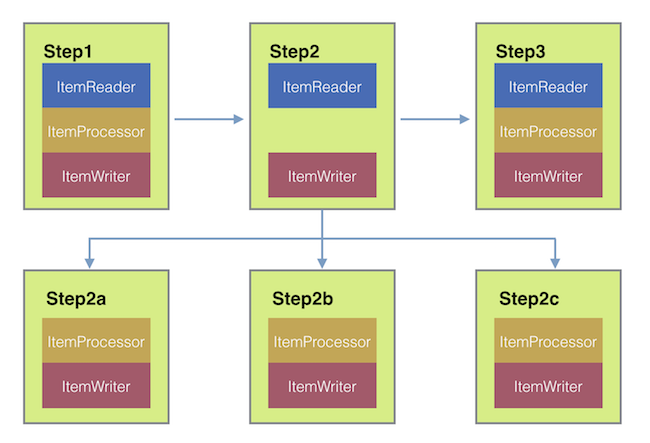
Taking things one step further, you can also externalize the
chunk processing by using the
ChunkMessageChannelItemWriter
(provided by Spring Batch Integration), which sends items out
and collects the result. Once sent, Spring Batch continues the
process of reading and grouping items, without waiting for the results.
Rather, it is the responsibility of the ChunkMessageChannelItemWriter
to gather the results and integrate them back into the Spring Batch process.
With Spring Integration, you have full
control over the concurrency of your processes (for instance, by
using a QueueChannel instead of a
DirectChannel). Furthermore, by relying on
Spring Integration’s rich collection of channel adapters (such as
JMS and AMQP), you can distribute chunks of a batch job to
external systems for processing.
A job with a step to be remotely chunked might have a configuration similar to the following in XML:
<job id="personJob">
<step id="step1">
<tasklet>
<chunk reader="itemReader" writer="itemWriter" commit-interval="200"/>
</tasklet>
...
</step>
</job>A job with a step to be remotely chunked might have a configuration similar to the following in Java:
public Job chunkJob() {
return jobBuilderFactory.get("personJob")
.start(stepBuilderFactory.get("step1")
.<Person, Person>chunk(200)
.reader(itemReader())
.writer(itemWriter())
.build())
.build();
}
The ItemReader reference points to the bean you want to use for reading data on the
manager. The ItemWriter reference points to a special ItemWriter (called
ChunkMessageChannelItemWriter), as described earlier. The processor (if any) is left off
the manager configuration, as it is configured on the worker. You should check any
additional component properties, such as throttle limits and so on, when implementing
your use case.
The following XML configuration provides a basic manager setup:
<bean id="connectionFactory" class="org.apache.activemq.ActiveMQConnectionFactory">
<property name="brokerURL" value="tcp://localhost:61616"/>
</bean>
<int-jms:outbound-channel-adapter id="jmsRequests" destination-name="requests"/>
<bean id="messagingTemplate"
class="org.springframework.integration.core.MessagingTemplate">
<property name="defaultChannel" ref="requests"/>
<property name="receiveTimeout" value="2000"/>
</bean>
<bean id="itemWriter"
class="org.springframework.batch.integration.chunk.ChunkMessageChannelItemWriter"
scope="step">
<property name="messagingOperations" ref="messagingTemplate"/>
<property name="replyChannel" ref="replies"/>
</bean>
<int:channel id="replies">
<int:queue/>
</int:channel>
<int-jms:message-driven-channel-adapter id="jmsReplies"
destination-name="replies"
channel="replies"/>The following Java configuration provides a basic manager setup:
@Bean
public org.apache.activemq.ActiveMQConnectionFactory connectionFactory() {
ActiveMQConnectionFactory factory = new ActiveMQConnectionFactory();
factory.setBrokerURL("tcp://localhost:61616");
return factory;
}
/*
* Configure outbound flow (requests going to workers)
*/
@Bean
public DirectChannel requests() {
return new DirectChannel();
}
@Bean
public IntegrationFlow outboundFlow(ActiveMQConnectionFactory connectionFactory) {
return IntegrationFlow
.from(requests())
.handle(Jms.outboundAdapter(connectionFactory).destination("requests"))
.get();
}
/*
* Configure inbound flow (replies coming from workers)
*/
@Bean
public QueueChannel replies() {
return new QueueChannel();
}
@Bean
public IntegrationFlow inboundFlow(ActiveMQConnectionFactory connectionFactory) {
return IntegrationFlow
.from(Jms.messageDrivenChannelAdapter(connectionFactory).destination("replies"))
.channel(replies())
.get();
}
/*
* Configure the ChunkMessageChannelItemWriter
*/
@Bean
public ItemWriter<Integer> itemWriter() {
MessagingTemplate messagingTemplate = new MessagingTemplate();
messagingTemplate.setDefaultChannel(requests());
messagingTemplate.setReceiveTimeout(2000);
ChunkMessageChannelItemWriter<Integer> chunkMessageChannelItemWriter
= new ChunkMessageChannelItemWriter<>();
chunkMessageChannelItemWriter.setMessagingOperations(messagingTemplate);
chunkMessageChannelItemWriter.setReplyChannel(replies());
return chunkMessageChannelItemWriter;
}
The preceding configuration provides us with a number of beans. We
configure our messaging middleware by using ActiveMQ and the
inbound and outbound JMS adapters provided by Spring Integration. As
shown, our itemWriter bean, which is
referenced by our job step, uses the
ChunkMessageChannelItemWriter to write chunks over the
configured middleware.
Now we can move on to the worker configuration, as the following example shows:
The following example shows the worker configuration in XML:
<bean id="connectionFactory" class="org.apache.activemq.ActiveMQConnectionFactory">
<property name="brokerURL" value="tcp://localhost:61616"/>
</bean>
<int:channel id="requests"/>
<int:channel id="replies"/>
<int-jms:message-driven-channel-adapter id="incomingRequests"
destination-name="requests"
channel="requests"/>
<int-jms:outbound-channel-adapter id="outgoingReplies"
destination-name="replies"
channel="replies">
</int-jms:outbound-channel-adapter>
<int:service-activator id="serviceActivator"
input-channel="requests"
output-channel="replies"
ref="chunkProcessorChunkHandler"
method="handleChunk"/>
<bean id="chunkProcessorChunkHandler"
class="org.springframework.batch.integration.chunk.ChunkProcessorChunkHandler">
<property name="chunkProcessor">
<bean class="org.springframework.batch.core.step.item.SimpleChunkProcessor">
<property name="itemWriter">
<bean class="io.spring.sbi.PersonItemWriter"/>
</property>
<property name="itemProcessor">
<bean class="io.spring.sbi.PersonItemProcessor"/>
</property>
</bean>
</property>
</bean>The following example shows the worker configuration in Java:
@Bean
public org.apache.activemq.ActiveMQConnectionFactory connectionFactory() {
ActiveMQConnectionFactory factory = new ActiveMQConnectionFactory();
factory.setBrokerURL("tcp://localhost:61616");
return factory;
}
/*
* Configure inbound flow (requests coming from the manager)
*/
@Bean
public DirectChannel requests() {
return new DirectChannel();
}
@Bean
public IntegrationFlow inboundFlow(ActiveMQConnectionFactory connectionFactory) {
return IntegrationFlow
.from(Jms.messageDrivenChannelAdapter(connectionFactory).destination("requests"))
.channel(requests())
.get();
}
/*
* Configure outbound flow (replies going to the manager)
*/
@Bean
public DirectChannel replies() {
return new DirectChannel();
}
@Bean
public IntegrationFlow outboundFlow(ActiveMQConnectionFactory connectionFactory) {
return IntegrationFlow
.from(replies())
.handle(Jms.outboundAdapter(connectionFactory).destination("replies"))
.get();
}
/*
* Configure the ChunkProcessorChunkHandler
*/
@Bean
@ServiceActivator(inputChannel = "requests", outputChannel = "replies")
public ChunkProcessorChunkHandler<Integer> chunkProcessorChunkHandler() {
ChunkProcessor<Integer> chunkProcessor
= new SimpleChunkProcessor<>(itemProcessor(), itemWriter());
ChunkProcessorChunkHandler<Integer> chunkProcessorChunkHandler
= new ChunkProcessorChunkHandler<>();
chunkProcessorChunkHandler.setChunkProcessor(chunkProcessor);
return chunkProcessorChunkHandler;
}
Most of these configuration items should look familiar from the
manager configuration. Workers do not need access to
the Spring Batch JobRepository nor
to the actual job configuration file. The main bean of interest
is the chunkProcessorChunkHandler. The
chunkProcessor property of ChunkProcessorChunkHandler takes a
configured SimpleChunkProcessor, which is where you would provide a reference to your
ItemWriter (and, optionally, your
ItemProcessor) that will run on the worker
when it receives chunks from the manager.
For more information, see the section of the “Scalability” chapter on Remote Chunking.
Starting from version 4.1, Spring Batch Integration introduces the @EnableBatchIntegration
annotation that can be used to simplify a remote chunking setup. This annotation provides
two beans that you can autowire in your application context:
-
RemoteChunkingManagerStepBuilderFactory: Configures the manager step -
RemoteChunkingWorkerBuilder: Configures the remote worker integration flow
These APIs take care of configuring a number of components, as the following diagram shows:

On the manager side, the RemoteChunkingManagerStepBuilderFactory lets you
configure a manager step by declaring:
-
The item reader to read items and send them to workers
-
The output channel ("Outgoing requests") to send requests to workers
-
The input channel ("Incoming replies") to receive replies from workers
You need not explicitly configure ChunkMessageChannelItemWriter and the MessagingTemplate.
(You can still explicitly configure them if find a reason to do so).
On the worker side, the RemoteChunkingWorkerBuilder lets you configure a worker to:
-
Listen to requests sent by the manager on the input channel (“Incoming requests”)
-
Call the
handleChunkmethod ofChunkProcessorChunkHandlerfor each request with the configuredItemProcessorandItemWriter -
Send replies on the output channel (“Outgoing replies”) to the manager
You need not explicitly configure the SimpleChunkProcessor
and the ChunkProcessorChunkHandler. (You can still explicitly configure them if you find
a reason to do so).
The following example shows how to use these APIs:
@EnableBatchIntegration
@EnableBatchProcessing
public class RemoteChunkingJobConfiguration {
@Configuration
public static class ManagerConfiguration {
@Autowired
private RemoteChunkingManagerStepBuilderFactory managerStepBuilderFactory;
@Bean
public TaskletStep managerStep() {
return this.managerStepBuilderFactory.get("managerStep")
.chunk(100)
.reader(itemReader())
.outputChannel(requests()) // requests sent to workers
.inputChannel(replies()) // replies received from workers
.build();
}
// Middleware beans setup omitted
}
@Configuration
public static class WorkerConfiguration {
@Autowired
private RemoteChunkingWorkerBuilder workerBuilder;
@Bean
public IntegrationFlow workerFlow() {
return this.workerBuilder
.itemProcessor(itemProcessor())
.itemWriter(itemWriter())
.inputChannel(requests()) // requests received from the manager
.outputChannel(replies()) // replies sent to the manager
.build();
}
// Middleware beans setup omitted
}
}
You can find a complete example of a remote chunking job here.
Remote Partitioning
The following image shows a typical remote partitioning situation:
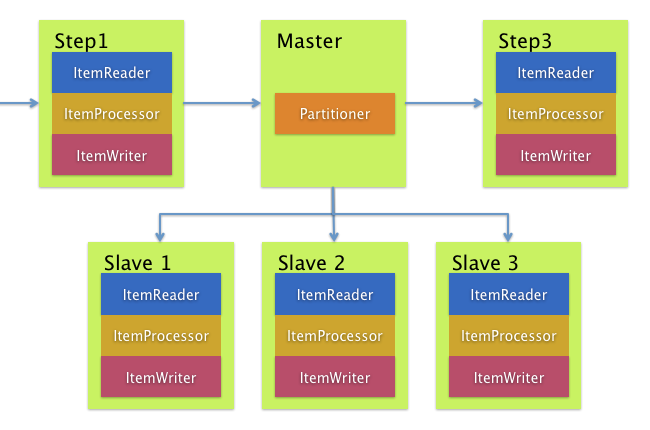
Remote Partitioning, on the other hand, is useful when it
is not the processing of items but rather the associated I/O that
causes the bottleneck. With remote partitioning, you can send work
to workers that execute complete Spring Batch
steps. Thus, each worker has its own ItemReader, ItemProcessor, and
ItemWriter. For this purpose, Spring Batch
Integration provides the MessageChannelPartitionHandler.
This implementation of the PartitionHandler
interface uses MessageChannel instances to
send instructions to remote workers and receive their responses.
This provides a nice abstraction from the transports (such as JMS
and AMQP) being used to communicate with the remote workers.
The section of the “Scalability” chapter that addresses
remote partitioning provides an overview of the concepts and
components needed to configure remote partitioning and shows an
example of using the default
TaskExecutorPartitionHandler to partition
in separate local threads of execution. For remote partitioning
to multiple JVMs, two additional components are required:
-
A remoting fabric or grid environment
-
A
PartitionHandlerimplementation that supports the desired remoting fabric or grid environment
Similar to remote chunking, you can use JMS as the “remoting fabric”. In that case, use
a MessageChannelPartitionHandler instance as the PartitionHandler implementation,
as described earlier.
The following example assumes an existing partitioned job and focuses on the
MessageChannelPartitionHandler and JMS configuration in XML:
<bean id="partitionHandler"
class="org.springframework.batch.integration.partition.MessageChannelPartitionHandler">
<property name="stepName" value="step1"/>
<property name="gridSize" value="3"/>
<property name="replyChannel" ref="outbound-replies"/>
<property name="messagingOperations">
<bean class="org.springframework.integration.core.MessagingTemplate">
<property name="defaultChannel" ref="outbound-requests"/>
<property name="receiveTimeout" value="100000"/>
</bean>
</property>
</bean>
<int:channel id="outbound-requests"/>
<int-jms:outbound-channel-adapter destination="requestsQueue"
channel="outbound-requests"/>
<int:channel id="inbound-requests"/>
<int-jms:message-driven-channel-adapter destination="requestsQueue"
channel="inbound-requests"/>
<bean id="stepExecutionRequestHandler"
class="org.springframework.batch.integration.partition.StepExecutionRequestHandler">
<property name="jobExplorer" ref="jobExplorer"/>
<property name="stepLocator" ref="stepLocator"/>
</bean>
<int:service-activator ref="stepExecutionRequestHandler" input-channel="inbound-requests"
output-channel="outbound-staging"/>
<int:channel id="outbound-staging"/>
<int-jms:outbound-channel-adapter destination="stagingQueue"
channel="outbound-staging"/>
<int:channel id="inbound-staging"/>
<int-jms:message-driven-channel-adapter destination="stagingQueue"
channel="inbound-staging"/>
<int:aggregator ref="partitionHandler" input-channel="inbound-staging"
output-channel="outbound-replies"/>
<int:channel id="outbound-replies">
<int:queue/>
</int:channel>
<bean id="stepLocator"
class="org.springframework.batch.integration.partition.BeanFactoryStepLocator" />The following example assumes an existing partitioned job and focuses on the
MessageChannelPartitionHandler and JMS configuration in Java:
/*
* Configuration of the manager side
*/
@Bean
public PartitionHandler partitionHandler() {
MessageChannelPartitionHandler partitionHandler = new MessageChannelPartitionHandler();
partitionHandler.setStepName("step1");
partitionHandler.setGridSize(3);
partitionHandler.setReplyChannel(outboundReplies());
MessagingTemplate template = new MessagingTemplate();
template.setDefaultChannel(outboundRequests());
template.setReceiveTimeout(100000);
partitionHandler.setMessagingOperations(template);
return partitionHandler;
}
@Bean
public QueueChannel outboundReplies() {
return new QueueChannel();
}
@Bean
public DirectChannel outboundRequests() {
return new DirectChannel();
}
@Bean
public IntegrationFlow outboundJmsRequests() {
return IntegrationFlow.from("outboundRequests")
.handle(Jms.outboundGateway(connectionFactory())
.requestDestination("requestsQueue"))
.get();
}
@Bean
@ServiceActivator(inputChannel = "inboundStaging")
public AggregatorFactoryBean partitioningMessageHandler() throws Exception {
AggregatorFactoryBean aggregatorFactoryBean = new AggregatorFactoryBean();
aggregatorFactoryBean.setProcessorBean(partitionHandler());
aggregatorFactoryBean.setOutputChannel(outboundReplies());
// configure other propeties of the aggregatorFactoryBean
return aggregatorFactoryBean;
}
@Bean
public DirectChannel inboundStaging() {
return new DirectChannel();
}
@Bean
public IntegrationFlow inboundJmsStaging() {
return IntegrationFlow
.from(Jms.messageDrivenChannelAdapter(connectionFactory())
.configureListenerContainer(c -> c.subscriptionDurable(false))
.destination("stagingQueue"))
.channel(inboundStaging())
.get();
}
/*
* Configuration of the worker side
*/
@Bean
public StepExecutionRequestHandler stepExecutionRequestHandler() {
StepExecutionRequestHandler stepExecutionRequestHandler = new StepExecutionRequestHandler();
stepExecutionRequestHandler.setJobExplorer(jobExplorer);
stepExecutionRequestHandler.setStepLocator(stepLocator());
return stepExecutionRequestHandler;
}
@Bean
@ServiceActivator(inputChannel = "inboundRequests", outputChannel = "outboundStaging")
public StepExecutionRequestHandler serviceActivator() throws Exception {
return stepExecutionRequestHandler();
}
@Bean
public DirectChannel inboundRequests() {
return new DirectChannel();
}
public IntegrationFlow inboundJmsRequests() {
return IntegrationFlow
.from(Jms.messageDrivenChannelAdapter(connectionFactory())
.configureListenerContainer(c -> c.subscriptionDurable(false))
.destination("requestsQueue"))
.channel(inboundRequests())
.get();
}
@Bean
public DirectChannel outboundStaging() {
return new DirectChannel();
}
@Bean
public IntegrationFlow outboundJmsStaging() {
return IntegrationFlow.from("outboundStaging")
.handle(Jms.outboundGateway(connectionFactory())
.requestDestination("stagingQueue"))
.get();
}
You must also ensure that the partition handler attribute maps to the partitionHandler
bean.
The following example maps the partition handler attribute to the partitionHandler in
XML:
<job id="personJob">
<step id="step1.manager">
<partition partitioner="partitioner" handler="partitionHandler"/>
...
</step>
</job>The following example maps the partition handler attribute to the partitionHandler in
Java:
public Job personJob() {
return jobBuilderFactory.get("personJob")
.start(stepBuilderFactory.get("step1.manager")
.partitioner("step1.worker", partitioner())
.partitionHandler(partitionHandler())
.build())
.build();
}
You can find a complete example of a remote partitioning job here.
You can use the @EnableBatchIntegration annotation to simplify a remote
partitioning setup. This annotation provides two beans that are useful for remote partitioning:
-
RemotePartitioningManagerStepBuilderFactory: Configures the manager step -
RemotePartitioningWorkerStepBuilderFactory: Configures the worker step
These APIs take care of configuring a number of components, as the following diagrams show:
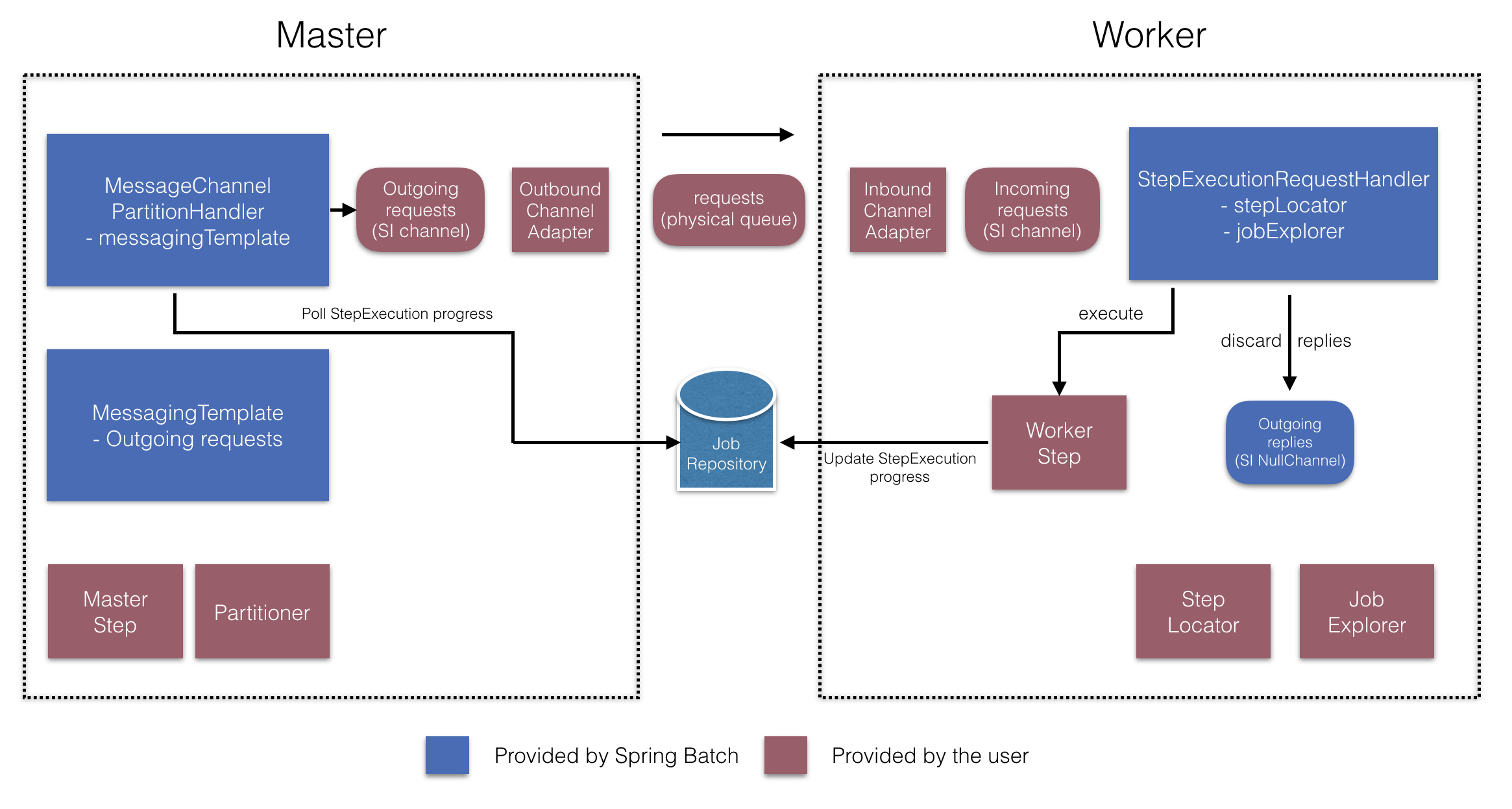
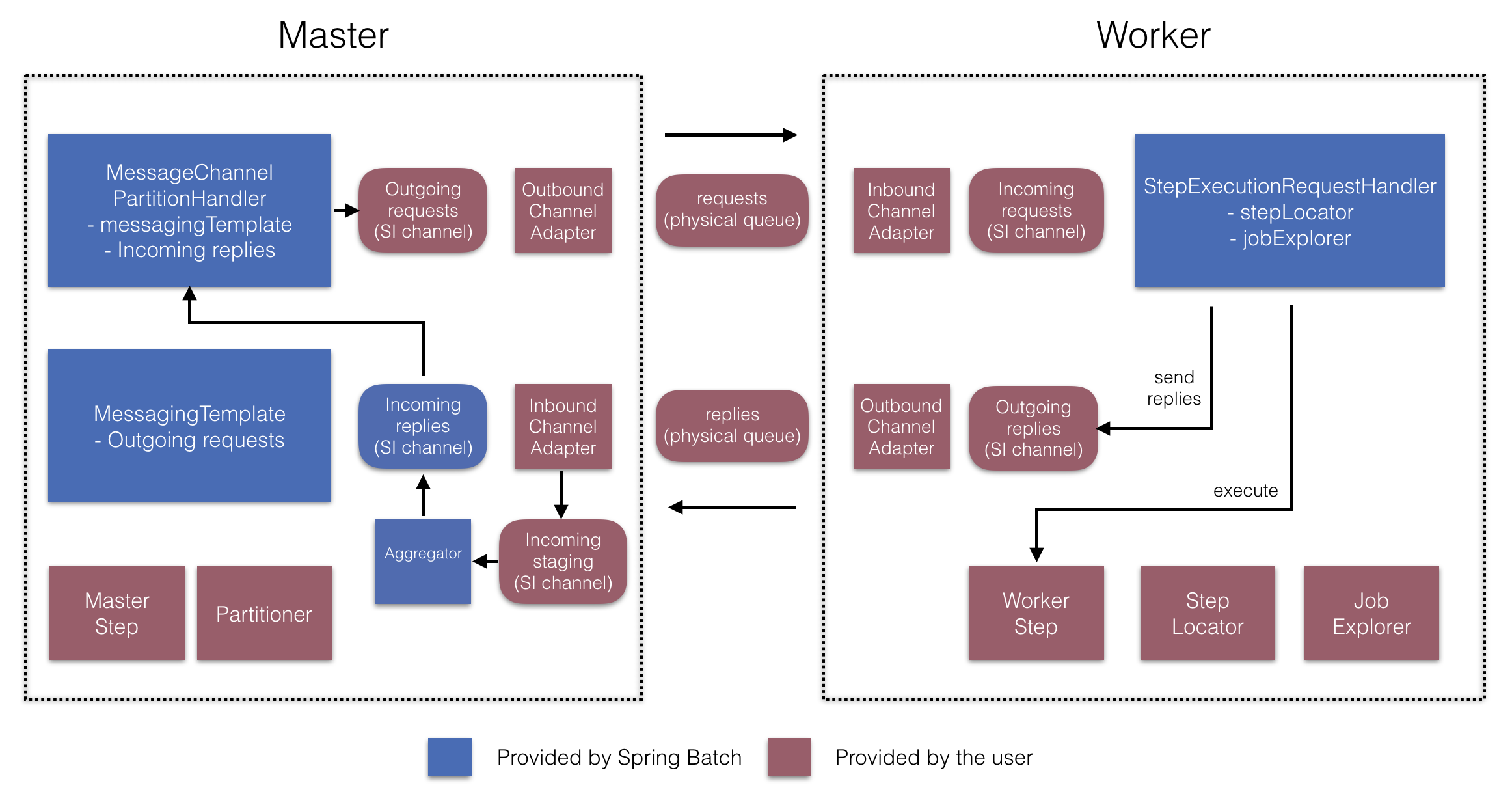
On the manager side, the RemotePartitioningManagerStepBuilderFactory lets you
configure a manager step by declaring:
-
The
Partitionerused to partition data -
The output channel (“Outgoing requests”) on which to send requests to workers
-
The input channel (“Incoming replies”) on which to receive replies from workers (when configuring replies aggregation)
-
The poll interval and timeout parameters (when configuring job repository polling)
You need not explicitly configure The MessageChannelPartitionHandler and the MessagingTemplate.
(You can still explicitly configured them if you find a reason to do so).
On the worker side, the RemotePartitioningWorkerStepBuilderFactory lets you configure a worker to:
-
Listen to requests sent by the manager on the input channel (“Incoming requests”)
-
Call the
handlemethod ofStepExecutionRequestHandlerfor each request -
Send replies on the output channel (“Outgoing replies”) to the manager
You need not explicitly configure the StepExecutionRequestHandler.
(You can explicitly configure it if you find a reason to do so).
The following example shows how to use these APIs:
@Configuration
@EnableBatchProcessing
@EnableBatchIntegration
public class RemotePartitioningJobConfiguration {
@Configuration
public static class ManagerConfiguration {
@Autowired
private RemotePartitioningManagerStepBuilderFactory managerStepBuilderFactory;
@Bean
public Step managerStep() {
return this.managerStepBuilderFactory
.get("managerStep")
.partitioner("workerStep", partitioner())
.gridSize(10)
.outputChannel(outgoingRequestsToWorkers())
.inputChannel(incomingRepliesFromWorkers())
.build();
}
// Middleware beans setup omitted
}
@Configuration
public static class WorkerConfiguration {
@Autowired
private RemotePartitioningWorkerStepBuilderFactory workerStepBuilderFactory;
@Bean
public Step workerStep() {
return this.workerStepBuilderFactory
.get("workerStep")
.inputChannel(incomingRequestsFromManager())
.outputChannel(outgoingRepliesToManager())
.chunk(100)
.reader(itemReader())
.processor(itemProcessor())
.writer(itemWriter())
.build();
}
// Middleware beans setup omitted
}
}